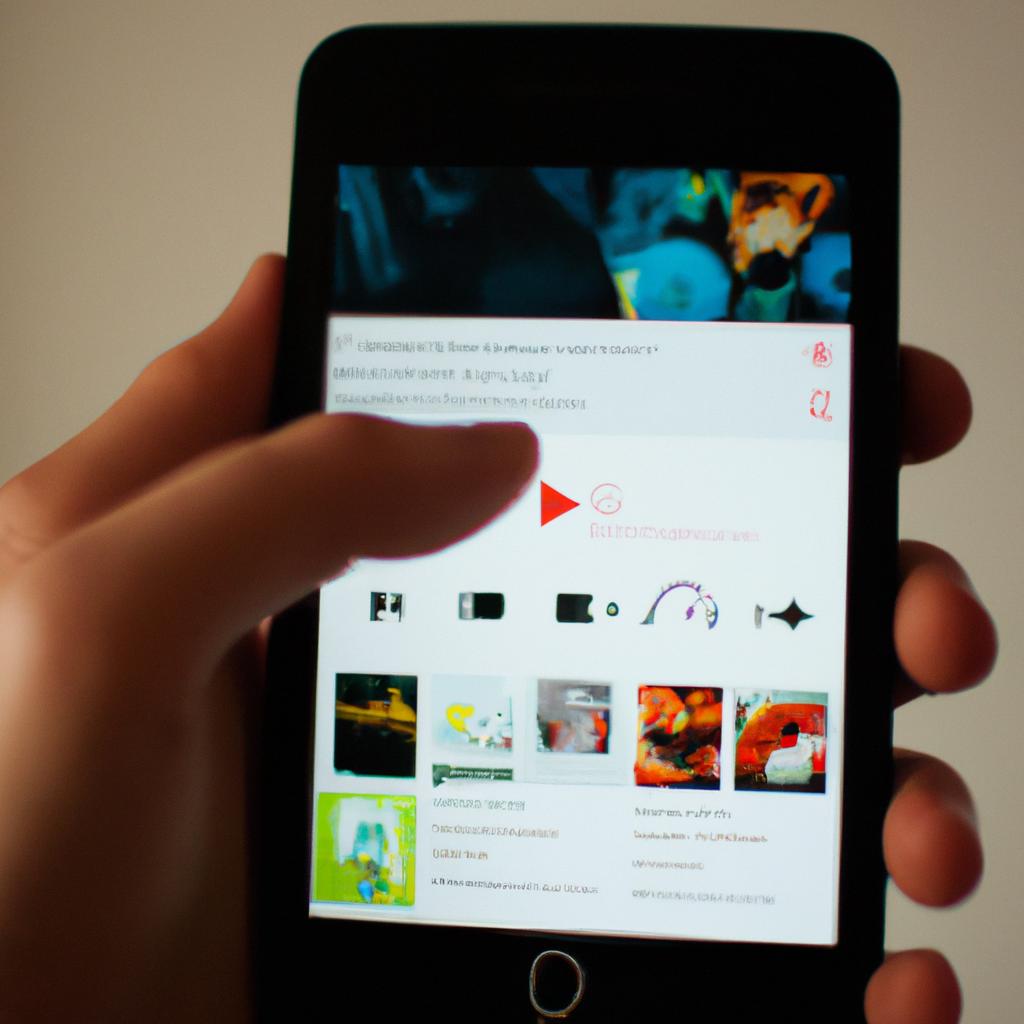The ever-evolving landscape of the entertainment industry has witnessed a significant shift in recent years, with music streaming emerging as one of the dominant platforms for accessing and discovering new music. This article aims to provide readers with a comprehensive guide on how to follow their favorite artists through various music streaming services. By examining both the benefits and challenges associated with this digital revolution, individuals will gain insight into how they can navigate the vast array of options available.
Consider the case study of Sarah, an avid music lover who finds herself overwhelmed by the multitude of streaming platforms at her disposal. Despite her passion for staying up-to-date with her favorite artists’ latest releases, she is unsure about which service best suits her needs. Through exploring different tiers of subscriptions, user-friendly interfaces, and personalized recommendations offered by leading providers such as Spotify or Apple Music, Sarah can make informed decisions regarding which platform aligns most closely with her musical preferences. Consequently, understanding the intricacies of music streaming not only enhances listeners’ experiences but also allows them to actively engage and support their beloved musicians in this fast-paced era of online entertainment consumption.
The Evolution of Digital Music
The Evolution of Digital Music
Imagine a time when music lovers had to rely solely on physical formats like vinyl records, cassette tapes, or compact discs to enjoy their favorite songs. Fast forward to the present day and we find ourselves in an era where digital music has become the dominant force in the entertainment industry. This section explores the evolution of digital music, highlighting its impact on both artists and listeners.
As technology advanced, MP3 files revolutionized how we consume music. With the advent of peer-to-peer file sharing platforms such as Napster in the late 1990s, music enthusiasts gained unprecedented access to vast libraries of songs at their fingertips. Suddenly, individuals could effortlessly share and distribute music with others around the globe. However, this newfound convenience came at a cost: rampant piracy threatened musicians’ livelihoods and challenged traditional revenue models within the recording industry.
To combat these challenges, major record labels began embracing legal streaming services as a means of adapting to changing consumer preferences. Companies like Spotify emerged as pioneers in this new landscape by offering vast catalogs of music that users could stream for free or through premium subscriptions. Streaming not only provided convenient access to millions of songs but also introduced personalized recommendations based on user preferences, further enhancing the overall listening experience.
The rise of digital music and streaming platforms has brought about significant changes in the way artists engage with their audience. It is no longer sufficient for musicians to solely focus on creating remarkable content; they must now navigate complex marketing strategies to stand out amidst fierce competition. To illustrate this point, consider the following bullet points:
- Artists are increasingly reliant on social media platforms to build a loyal fan base.
- Collaborations between artists from different genres have become more common and often lead to greater exposure.
- Live performances have taken center stage as a primary source of income for many musicians.
- Musicians must adapt constantly by engaging with fans through behind-the-scenes content and interactive experiences.
Furthermore, the table below highlights key aspects of the evolution of digital music:
| Physical Formats | Digital Music | |
|---|---|---|
| Access | Limited | Instantaneous and global |
| Portability | Bulky | Portable through various devices |
| Storage | Space-consuming | Virtually infinite with cloud storage |
| Revenue Generation | Album sales | Streaming subscriptions, live performances, merchandise |
In conclusion, the shift from physical formats to digital music has transformed how artists create and distribute their work. With an emphasis on streaming platforms and online engagement, musicians must navigate a rapidly changing landscape to succeed in the industry. The subsequent section will delve into the rise of artist-focused streaming platforms as a response to these evolving dynamics.
The Rise of Artist-Focused Streaming Platforms
The Rise of Artist-Focused Streaming Platforms
From the early days of Napster to the present, digital music has undergone a remarkable transformation. With streaming services now dominating the entertainment industry, artists and listeners alike have adapted to this new era of consuming music. The rise of artist-focused streaming platforms has taken center stage, revolutionizing how we discover and support our favorite musicians.
To understand the impact of these artist-focused streaming platforms, let’s take a closer look at an example: Spotify for Artists. This platform allows musicians to not only upload their own tracks but also gain insights into their audience demographics and track performance metrics. By providing artists with this valuable data, they can better tailor their content and marketing strategies to reach their target audience effectively.
The emergence of artist-focused streaming platforms like Spotify for Artists highlights several key benefits that have propelled them to success:
- Direct connection with fans: These platforms enable artists to establish direct relationships with their fan base by engaging in real-time interactions through comments sections or live chats during virtual performances.
- Increased exposure opportunities: Through curated playlists and algorithmic recommendations, these platforms expose lesser-known artists to wider audiences who may otherwise never encounter their music.
- Enhanced revenue streams: Artist-centric streaming platforms offer various monetization avenues such as merchandise sales, concert ticket promotions, and exclusive releases that boost artists’ income beyond just song streams.
- Valuable analytics tools: Providing detailed analytics on listener behaviors enables artists to make informed decisions about tour locations, promotional efforts, and collaborations.
| Benefit | Description |
|---|---|
| Direct connection | Establishing meaningful connections between artists and fans through interactive features |
| Increased exposure | Expanding visibility for emerging talents via personalized recommendations |
| Enhanced revenue | Offering diversified income sources through merchandise sales, concert promotions, etc. |
| Valuable analytics | Empowering decision-making based on comprehensive insights into listener preferences |
As we continue delving into the world of music streaming, it becomes apparent that exploring different platforms is crucial for both artists and listeners. By understanding the unique features and offerings of various services, individuals can make informed choices about which platform aligns best with their preferences and goals. In the following section, we will delve deeper into the diverse landscape of music streaming services available today.
Now let’s explore the wide array of options available to us as we embark on our journey through different music streaming services.
Exploring Different Music Streaming Services
The music streaming industry offers a wide range of platforms for users to choose from, each with its own unique features and offerings. Let’s delve into some popular music streaming services available today.
One such platform is Spotify, which has gained immense popularity worldwide. With its vast library of over 70 million songs, it provides users with access to a diverse range of artists and genres. In addition to individual tracks, Spotify also offers curated playlists and personalized recommendations based on user preferences. For example, imagine you’re a fan of alternative rock music; Spotify’s algorithm can create a playlist tailored specifically to your tastes, featuring both established bands and emerging artists within the genre.
When considering different music streaming services, there are several factors worth exploring:
- User Interface: The ease of use and intuitiveness of an interface can greatly impact the overall listening experience. A well-designed interface allows for seamless navigation through menus and effortless discovery of new content.
- Audio Quality: While most platforms offer standard audio quality, some premium subscriptions provide higher fidelity options that enhance the listening experience for audiophiles.
- Social Integration: Some platforms incorporate social features that allow users to share their favorite tracks or playlists with friends, fostering a sense of community among music enthusiasts.
- Pricing Plans: Subscription costs vary across different platforms depending on the level of service desired – whether it be ad-supported free plans or premium subscriptions offering additional benefits like offline playback and exclusive content.
To further illustrate these differences in features and pricing plans between various music streaming services, consider the following table:
| Platform | Free Plan Features | Premium Plan Features |
|---|---|---|
| Spotify | Limited skips | Ad-free listening |
| Apple Music | No ads | Access to entire catalog |
| Amazon Music | Ad-supported | Offline playback |
| Tidal | Limited playlist access | High-fidelity audio |
In conclusion, exploring different music streaming services allows users to find a platform that aligns with their preferences and enhances their music listening experience. The availability of various features, user-friendly interfaces, audio quality options, social integration, and pricing plans contribute to the diverse landscape of music streaming platforms.
Next, let’s dive into the benefits of following your favorite artists on these platforms and how it can deepen your connection with their work.
Benefits of Following Your Favorite Artists
Imagine you are an avid fan of a rising music artist, let’s call her Sarah. You love her unique sound and can’t wait to hear her new releases. In the past, keeping up with your favorite artists might have been challenging, but thanks to music streaming services, staying connected has never been easier.
There are numerous music streaming services available today that offer a wide range of content and features. Each platform caters to different preferences and needs, allowing users like yourself to access a vast library of songs from various genres. For instance, Spotify is known for its personalized playlists and algorithm-based recommendations, while Apple Music offers exclusive interviews and behind-the-scenes footage. By exploring different streaming services, you gain access to diverse experiences tailored to suit your musical taste.
To help you navigate through this sea of options effectively, here are some key factors to consider when choosing a music streaming service:
- Library Size: Look for platforms that boast extensive catalogs encompassing both popular hits and lesser-known gems.
- Audio Quality: If audio fidelity matters to you, prioritize services that provide high-quality sound formats such as lossless or Hi-Res audio.
- User Interface: An intuitive interface enhances user experience by making it easy to discover new music and manage curated playlists effortlessly.
- Platform Compatibility: Ensure the service aligns with your preferred devices (e.g., smartphones, tablets, smart speakers) so you can enjoy seamless listening across all platforms.
Now that we understand the importance of exploring different music streaming options let’s delve into the next section – “Benefits of Following Your Favorite Artists.” This will shed light on why connecting directly with artists through these platforms can enhance your overall music experience while supporting their creative journey.
Tips to Stay Updated with New Releases
Following Your Favorite Artists: A Gateway to the Latest Releases
Imagine this scenario: You are a devoted fan of an up-and-coming indie band. You have been eagerly waiting for their new album release, hoping to get your hands on it as soon as possible. In the past, you might have relied on traditional methods like visiting physical music stores or constantly checking online retailers for updates. However, with the advent of music streaming platforms, staying updated with new releases from your favorite artists has become easier and more convenient than ever before.
One key benefit of following your favorite artists on music streaming platforms is that you gain immediate access to their latest releases. As soon as a new song or album drops, it becomes readily available in your personal library without any additional effort or cost. This ensures that you are always at the forefront of discovering fresh tracks and staying connected with the evolving musical landscape.
To maximize your experience and make the most out of following your favorite artists, here are some practical tips:
-
Create personalized playlists: Curate playlists based on different moods or themes using songs by your preferred artists. This allows you to immerse yourself in a tailored listening experience while also being exposed to other similar musicians who may share a sonic aesthetic.
-
Enable notifications: Most music streaming platforms offer notification settings that alert you when new content from your followed artists is released. By enabling these notifications, you can stay informed about upcoming singles, albums, collaborations, or even exclusive behind-the-scenes footage.
-
Explore related artist suggestions: Music streaming services often generate recommendations based on your listening habits and preferences. Take advantage of these suggestions to discover lesser-known but equally talented artists operating within similar genres or styles.
-
Engage with artist-curated playlists: Many musicians create their own playlists featuring both their own work and songs they enjoy listening to personally. Exploring these curated selections not only offers valuable insight into an artist’s influences but also exposes you to new music that aligns with your tastes.
The table below provides a visual representation of the benefits and features associated with following your favorite artists on music streaming platforms:
| Benefits | Features |
|---|---|
| Immediate access | Instant availability of new releases |
| Personalized playlists | Customizable mood-based collections |
| Timely notifications | Alerts for upcoming content |
| Discover new artists | Recommendations based on preferences |
By actively engaging with these elements, you can enhance your overall music streaming experience while ensuring you never miss out on exciting updates from your beloved musicians. In doing so, not only do you stay connected as a fan, but you also contribute to the growing impact of artist-focused streaming on the wider music industry.
Transitioning into the next section about “Impact of Artist-Focused Streaming on the Music Industry,” it is fascinating to consider how this shift in consumer behavior has influenced various aspects of the entertainment landscape.
Impact of Artist-Focused Streaming on the Music Industry
The landscape of the music industry has transformed significantly with the rise of artist-focused streaming platforms. Artists now have more control over their content and can directly connect with their fans, resulting in a shift in how music is consumed and shared. This section explores the impact that artist-focused streaming has had on the music industry, highlighting its benefits for both artists and listeners.
One notable example of an artist-focused streaming platform is Spotify, which allows users to follow their favorite artists and receive updates about new releases directly from those artists. For instance, imagine being a fan of Taylor Swift who just released her latest album. By following her on Spotify, you would be notified as soon as she drops new songs or albums, ensuring that you stay up-to-date with her musical journey.
To fully grasp the significance of artist-focused streaming platforms like Spotify, consider these key points:
- Increased Accessibility: Artist-focused streaming platforms allow audiences worldwide to access music easily at any time, transcending geographical boundaries.
- Direct Fan Engagement: These platforms facilitate direct communication between artists and fans through features such as exclusive behind-the-scenes content and personalized playlists.
- Discoverability: Listeners can explore new artists within similar genres or styles based on recommendations provided by the streaming platforms’ algorithms.
- Revenue Generation: Streaming services offer opportunities for artists to earn revenue through royalties based on their plays and streams.
To better illustrate this transformation in music consumption, let’s take a look at the following table:
| Traditional Model | Artist-Focused Streaming |
|---|---|
| Limited access | Global accessibility |
| Passive audience | Active engagement |
| Top-down promotion | Peer-to-peer sharing |
| Physical sales | Digital royalties |
As seen above, traditional models relied heavily on physical sales and top-down marketing strategies. However, artist-focused streaming has shifted power dynamics towards active engagement between artists and listeners while expanding global accessibility. This evolution has paved the way for a more intimate and immersive relationship between artists and their fans.
In summary, artist-focused streaming platforms have revolutionized the music industry by enabling direct fan engagement, increasing accessibility to music, facilitating discoverability of new artists, and providing revenue opportunities for musicians. As technology continues to advance, it is crucial for both artists and listeners to adapt to these changes in order to fully embrace the benefits offered by this evolving landscape.




